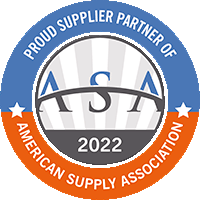Terminology
Commonly Used Abbreviations and their Definitions
A.B.: Aluminum Bronze. An alloy containing aluminum and bronze, used in the manufacture of butterfly valve discs. The combination of the two alloys offers moderate corrosion resistance, less weight on the valve’s seats and high strength and durability.
ABS: Acrylonitrile Butadiene-Styrene. A thermoplastic resin offering excellent corrosion resistance, tensile strength and a temperature rating matching CPVC (180 degrees Fahrenheit). ABS is used to manufacture valves, fittings and pipe.
BRS: Brass. An alloy containing a lesser amount of the element, copper as compared to Bronze. As a forging, brass is used to make valve bodies. Other variants of manufacture, including casting, allow broad usage of brass as both the main valve components (cast bodies) as well as trim components (stems, balls, packing nuts, etc.).
BRZ: Bronze. An alloy containing the element copper. Chiefly used to make valve bodies, it is typically cast into shape. Bronze has moderate corrosion resistance, and excellent high-temperature resistance.
C x C: Copper-by-Copper. A general description of both end connections of a fitting or valve, considered to be the abbreviated term for “copper tube size by copper tube size.” Typically used to express a transition from tubing to pipe (e.g. C x F.I.P.).
C.I. : Cast Iron. Describes the material type of certain valve components. Cast iron is comprised of the base element iron, and is mixed with other base elements, which results in the alloy, cast iron. Also known as Gray Iron.
CLO.: Close. Describes pipe nipple length. A nipple with no space between the pipe threads. Installations using a close nipple bring the two valves or fittings “close” to one another for space-saving reasons.
Compr. or Comp.: Compression. Describes a type of valve or fitting end connection which typically uses two or three components to create the mechanical joint and mechanical seal: A compression nut concentrically compresses a flexible (rubber) gasket, effectively creating a seal between the pipe or tubing.
CP: Chrome-Plated. Describes the electrostatic or dipped process of applying a chrome finish onto a valve or fitting for purpose of improving appearance or durability. There are two types of final chrome-plated finishes: Satin chrome plating and smooth chrome plating.
CPVC: Chlorinated Polyvinylchloride. A thermoplastic resin offering excellent corrosion resistance, tensile strength and superior temperature resistance compared to PVC. Like PVC, CPVC is also used to manufacture valves, fittings and tubing or pipe. It is joined by solvent welding or threading. In a valve application, its general W.O.G. rating is 150 p.s.i. at 73 degrees Fahrenheit, with a maximum temperature of 180 degrees Fahrenheit.
C.S.: Carbon Steel. Describes an alloy type typically used in the construction of valve bodies because of its exceptional strength properties. Can be cast or forged.
C.T.S.: Copper Tube Size. Describes the female end connection of a valve or fitting where copper tubing is inserted and joined by means of capillary action (soldering or sweating) or compression.
D.I. : Ductile Iron. Describes an alloy type of certain valve components. Ductile Iron is similar to cast iron in composition, but with an additional treatment applied during its construction. The result is a casting which approaches the strength properties of steel while still maintaining the advantages of the casting process.
EPDM: Ethylene-Propylene Diene Monomer. An extreme-service synthetic rubber used in valve applications as a seat or seal material because of its exceptional abrasion and tear resistance, moderate chemical resistance and excellent temperature range:
F.: Fahrenheit. A measurement of temperature in degrees, where at sea level’s barometric pressure, water freezes at 32 degrees and boils at 212 degrees.
F.F.: Flush-face. Describes a flange type, where the entire mating surface of the flange (the face) is machined to one smooth, even level across the entire surface. When joined with another flush-face flange, a full-face gasket must be used.
F.I.P.: Female Iron Pipe. Describes an internal pipe thread end connection, verses external.
Fl.: Flare. 1. Adj. Describes an end connection which uses two components to make the mechanical joint and mechanical seal between copper tubing and a valve or fitting. A flare nut is tightened onto the valve or fitting body, pinching the expanded copper tubing between itself and the rounded “bullnose” on the body. 2. Verb. The act of concentrically expanding the open end of soft copper tubing through the use of special flaring tools.
FLNG or FLG: Flange. Referencing a flange fitting or describing an end connection as being flanged. A flange is a cylindrical-shaped device with holes drilled through its flat surface around its circumference and center (a nominal-sized round port).
Ftg.: Fitting size. Describes a male tubing end connection typically inserted into a C.T.S. (female) end connection in a soldered joint. (See “street”).
F.U.E.: Female Union End: Describes an end connection, which uses two components to create the mechanical joint and mechanical seal. A union nut is threaded onto the body of a valve or fitting, which holds a F.I.P. nipple in place. Removable.
G.H.T.: Garden Hose Thread. Describes either internal or external threads, this thread type is proprietary and not compatible with any pipe threads. Typically identifies the end connections of the common garden hose, and not other hose types.
I.B.B.M.: Iron Body, Bronze Mount. In flanged cast iron valves, describing the “trim” components as being constructed of the alloy bronze (e.g. seat ring, wedge face ring, etc.).
I.D.: Inside Diameter. A measurement of the inside circular area of pipe or tubing (cylinder shape), measured from the inside wall across the center of the round opening, to the opposite inside wall.
I.P.S.: Iron Pipe Size Straight. Generic description of a pipe thread, typically confused with a tapered pipe thread.
M x F: Male-by-Female. Referencing the threaded end connections of one device. Typically describes a M.I.P.-by-F.I.P. valve or fitting, but can be used to reference any male-by-female thread type.
M.I.P.: Male Iron Pipe. Describes an external pipe thread end connection, typically threaded into a F.I.P. end connection.
M.U.E.: Male Union End: Describes an end connection, which uses two components to create the mechanical joint and mechanical seal. A union nut is threaded onto the body of a valve or fitting, which holds a M.I.P. nipple in place. Removable.
NBR: Nitrilc Butadiene Rubber. Trade name: Buna-N. A moderate-service synthetic rubber (polymer) typically used as a seat or o-ring seal in valves because of its abrasion resistance, resistance to degradation from petroleum-based medias, like gasoline or hydraulic fluid and moderate service temperature range: -20 to 180 degrees Fahrenheit.
N.P.T.: National Pipe Tapered Thread. Describes a thread type as a tapered pipe thread, as opposed to a straight pipe thread or other kind of threading.
N.R.S.: Non-Rising Stem. Describes the stem configuration of gate valves, where the stem is stationary inside of the bonnet and the disc moves up and down on the fixed stem. The handle height and external stem length remain the same despite disc position.
O.D.: Outside Diameter. A measurement of the outside circular area of pipe or tubing (cylinder shape), measured from the outermost circumference across the center of the round opening, to the opposite outermost circumference.
O. S. & Y.: Outside Screw and Yoke. Regarding flanged cast iron valves, this describes the stem, packing and disc relation as being a rising stem configuration.
PB: Polished Brass: Brass alloy that has been polished to a high luster for appearance reasons. Log lighter escutcheons are polished brass.
Pex: Cross-linked Polyethylene. Polyethylene resin which has been subject to a process known as cross-linking. Through one of several processes, bridge-type links are created between the polyethylene molecules, making them more durable, more resistant to higher temperatures and more chemical resistant. Typically extruded into tubing, it is used for hot water (up to 200 degrees F) or potable water applications.
P.J.: Pack-joint. Describes the end-connection type of a water service fitting. Incorporates a special compression nut which has a clamp, bolt and buttress-type threads, Buna-N rubber washer and anti-friction ring.
PP: Polypropylene. A thermoplastic polymer with exceptional stress fatigue resistance typically used to manufacture valves and fitting because of its resistance to imparting taste or odors into the media.
P.S.I.: Pressure rating; Pounds per Square Inch. Typically, a measure of pressure within an enclosed vessel.
PTFE: Polytetrafloroethylene. Trade name: Teflon. A Floro-elastomer widely used as a seat, packing or general seal material in valves because of its excellent resistance to elevated temperatures, broad chemical resistance, good compression set, low permeability, high durability and low friction coefficient. Typically an opaque white in color, in a valve application, the temperature range is –20 to 400 degrees Fahrenheit.
PVC: Polyvinylchloride: A thermoplastic resin offering excellent corrosion resistance, tensile strength and moderate temperature resistance. PVC is widely used in the manufacture of vales, fittings and pipe and is joined by solvent welding, threading or flanging. In a valve application its general W.O.G. rating is 150 p.s.i. at 73 degrees Fahrenheit, with a maximum temperature of 140 degrees Fahrenheit.
R.F.: Raised-face. Describes a flange type, where the mating surface (the face) inside of the bolt-hole diameter is machined higher than the surface outside of the bolt-hole diameter. This “raised” area allows for the use of a smaller diameter gasket. A raised-face flange can be joined to a flush-face flange.
R.S: Rising Stem. Describes the stem configuration of gate valves, where the stem moves upward and downward inside of the bonnet, and the disc is attached to the end of the stem, in a fixed position. The handle height and external stem length vary, depending on disc position. A.K.A. Outside Screw and Yoke.
S.S. : Stainless Steel. Describes an alloy type typically used in the construction of valve bodies and valve trim because of its strength and corrosion resistance. Cast or forged, a grade number is used to describe its type and corrosion resistance (e.g. 304 S.S., 316 S.S., 416 S.S.) The higher the number, the better its strength and resistance.
SBR: Styrene-Butadiene Rubber. A general-purpose synthetic rubber typically used in low temperature, low pressure valve and fitting applications. The maximum service temperature is 160 degrees Fahrenheit.
Sch. 40: Schedule 40. A measurement term used to describe the wall thickness of pipe in relation to its inside and outside diameters. PVC pipe is identified as Schedule 40 by tinting it white in color. A “standard” steel piece of pipe can also be identified as being Schedule 40.
Sch 80: Schedule 80. A measurement term used to describe the wall thickness of pipe in relation to its inside and outside diameters. Schedule 80 PVC pipe is commonly tinted dark grey and has a thicker wall thickness by means of reducing the inside diameter while keeping the outside diameter the same as steel pipe or schedule 40 PVC pipe.
Sh.: Shoulder. Describes pipe nipple length. The length immediately following the “close” length. E.g. ½” x Sh is the same as ½” x 1-1/2”. Typically, in nominal sizes 1/8” through ¾”, the shoulder length is 1-1/2”. In nominal sizes 1”, 1-1/4” and 1-1/2” the shoulder length is 2”. In nominal size 2” the shoulder length is 2-1/2”. In nominal sizes 2-1/2”, 3” and 4” the shoulder length is 3”.
Swt.: Sweat. 1. Adj. Another term for describing the female C.T.S. end connection of a valve or fitting. 2. Verb. The actual process of heating the juncture of copper tubing and valve or fitting (C.T.S.) end to create capillary action, the end result being the mechanical joint and mechanical seal. A.K.A. Soldering
T/S: Threaded or Sweat or, Threaded or Socket which describes a valve or fitting end connection having the option of using either type during installation.
TFM: A modified version of PTFE, which offers improved properties of strength, wear resistance, chemical attack resistance, thermal (heat) resistance, elasticity and a smoother surface over plain PTFE.
U.E.: Union End. Described the end connection of a valve or fitting which includes two machined faces held in tight contact with each other through the use of a union nut. The primary advantage of a union connection is that it is removable and re-attachable, verses permanent.
W.O.G.: A general pressure rating indicating maximum P.S.I. for the medias Water, Oil or Gaseous.
W.S.P.: Working Steam Pressure. A pressure rating specific to the media steam and expressed in P.S.I.
YB: Yellow Brass. An alloy containing approximately 60 per cent copper, typically used for cast valve bodies as a low-cost alternative verses bronze (e.g. T431 YB, T-433 YB and T-453 YB).



